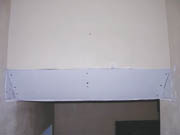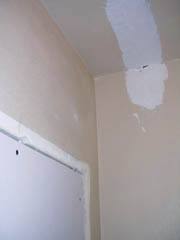Photo #1 shows a stairway-it's the spot where you come down from upstairs and people were clunking their head constantly, and finally got fed up with it. They had the contractor cut the wall down and slope it slightly. It got rid of the problem and I wanted to make a few comments about it. First, if you were doing this job, it would be a good idea to find out if there was a solid piece of backer behind the two areas where cornerbeads need to be hung.
For some reason, I've ran into quite a few of these situations where I need to hang a bead and there's nothing-or at least very little-behind to attach the beads to. It ends up I have to use construction adhesive of some sort to attach them. I mention this because when this happens, it's more time and the repair will not be able to be done the same day.
The beads will have to be attached and then you will have to make another trip, which equals more time and effort and therefore less money made. Bringing in a hammer and nail will help determine if such backers are in place.

TIP BIDDING
If I had to glue it into place, I'd probably arrange to come in at the end of the day, after I've done another job and glue them up. One more tip: You may have some place to put a nail or screw on the edges of the cornerbead to hold it in place but sometimes it works to hold the bead in place while the adhesive is hardening with duct tape. It holds very well and can be used with good effect. Then I'd go back the next day to plaster it in.One more thing about this picture: It brings up a tip in bidding. At times, I have an area I'm flat taping, meaning I am not going to "turn" the corner or edge. It happens a lot where a ceiling is done. New board is hung but the walls are existing plaster. I flat tape using fiberglass mesh right even with the board going into the corner. I fold 1/8 inch of the mesh onto the wall, just enough to make the turn. I then plaster the ceiling and the plaster covers the mesh. I don't have to go onto the wall and feather or blend it in.
This is an important point to keep in mind when bidding a project. It may look simple at first but if an angle has to be "turned," which is the case in photo #1, then a little more work is involved. The wall areas have to be matched and it might require blending them into an existing texture that's a challenge to match. I bring this up because a homeowner may feel it's a "small" job. Explaining and educating the homeowner is key here, so they appreciate what's involved. This will help them understand and accept why your estimate is higher than they may have expected. It's one thing to resurface or repair a ceiling area-quite another when it requires you turn the corner and blend the top edge of a ceiling 1 or 2 inches all the way around.

Be nice to the homeowner
Another recent project brings up some more tips to keep in mind. Photo #2 shows a wall where a window was removed and a piece of drywall was installed. And up in the corner, notice a hole that has been patched. The homeowner in this situation proudly announced he had "gotten it all ready for me to slap some mud on." Thanks but no thanks.The challenge here is not to hurt their feelings and at the same time break the news that you still have quite a bit of work to do. In this homeowner's mind, I just had to pop some mud in that crack between the board and existing plaster and in the hole in the corner. So, he had a different vision and view. Again, educating the homeowner is key here to a successful conclusion.
Many problem areas are made more complicated by a do-it-yourselfer who gets some kind of concoction together: a mixture of Elmer's glue, toothpaste, baking soda and some finely sifted flour, and globs it on. More often than not, it's more work to get the gunk off than to do the actual repair. Through consideration of the person's feelings, we often just scrape it off when they aren't looking (as I mentioned last month, music comes in handy to set the mood on the job and it also does wonders in covering up the sounds of scraping). In this case, the material they used was soft and didn't pose a problem. I bonded right over it and plastered the area with good effect-it didn't leave a hump or show at all.
For the wall, where the window was, remember my "1/3 rule." If more than a third of a surface is affected or damaged, I like to resurface the whole wall. That's what I recommended here. But before I do, there is another thing to watch for: Do you notice the drywall board is attached with screws? That's great. But what about the perimeter of the area surrounding it, where the existing plaster meets the drywall?
All the way around the edge, I could tap it and it was vibrating. Make sure and secure the existing plaster, too. It would be a sad thing to resurface and then have vibration cracks show up because the wall was not sound and secured first. For this project, I made sure it was secure, applied a bonding agent over it, then basecoated and embedded mesh where new met old. A basecoat was applied over the entire wall and then sand finish was applied to blend and match it to the existing walls.
Higher profits come from effective use of time. And a great reputation really rests on keeping the customer happy. I have been called into so many homes where terrible patching has been done-but has been done by the homeowner's grandmother or aunt. I am not going to complain or run down the job they did. Actually, I often tell homeowners that I never criticize an attempt that they make at a repair. If I had to use the materials they had available at stores, I don't know if I'd do much better myself.
Thank goodness for genuine plaster. It's still a goal to try and get real plastering materials available across the country. I just had a gentleman come in from Pennsylvania for personal training with me and he was able to load up on materials before he went back. Some of the materials are very hard to find in remote sections of the country. Well, here's hoping that improves soon!
I appreciate your letters and e-mails-keep them coming. And if you are interested in coming on board the Plaster Man cruise in September, be sure and check out the details at www.plasterzone.com. We'd love to have you on board! Until next time, Plaster On!

Report Abusive Comment